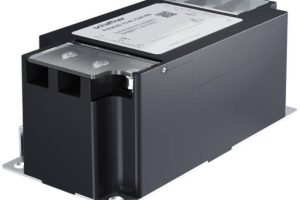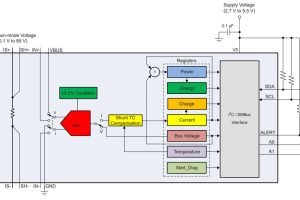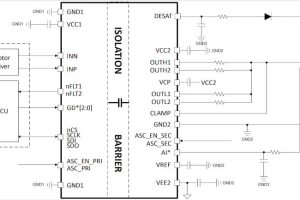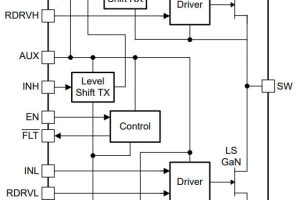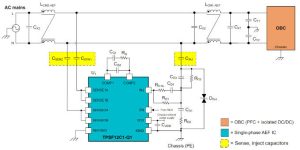
In principal, the ICs implement a capacitance multiplier circuit to emulate the Y-capacitors in a conventional passive filter design.
They do while sitting amongst smaller filter inductors and capacitors (top diagram) while summing the high-frequency components of the voltages from the two or four ac power conductors, and then injecting an anti-phase ac current derived from these signals back into the neutral.
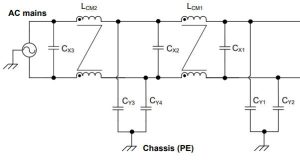 Compare the active circuit with this conventional passive EMC filter circuit
Compare the active circuit with this conventional passive EMC filter circuit
“The effective active capacitance is set by the circuit gain and the injection capacitance,” according to TI. “The active EMC filter sensing and injection impedances use relatively low capacitance values with small component
footprints.”
Scroll down to the bottom of this article for a discussion on where exactly currents flow in this scheme
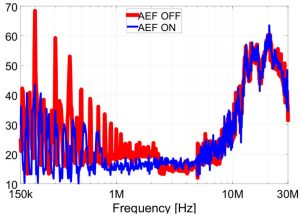 What ever the mechanism, the result, said TI, is a low impedance path for common-mode noise enabling “15 to 25dB of CM noise reduction over, for example, 150kHz to 3MHz, helping to reduce the size of common-mode chokes”. It also said: “as much as 30dB at between 100kHz and 3MHz” and that they are capable of “helping to meet CISPR 25 Class 5 EMI limits for conducted and radiated emissions”.
What ever the mechanism, the result, said TI, is a low impedance path for common-mode noise enabling “15 to 25dB of CM noise reduction over, for example, 150kHz to 3MHz, helping to reduce the size of common-mode chokes”. It also said: “as much as 30dB at between 100kHz and 3MHz” and that they are capable of “helping to meet CISPR 25 Class 5 EMI limits for conducted and radiated emissions”.
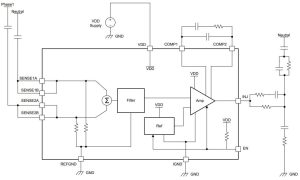 The difference between single and three phase versions is only the number of inputs provided to sense voltages – two or four respectively (diagram left, the three-phase version has four input load resistors). All of these signals are summed internally into a single ac signal, which is filtered appropriately before being re-injected.
The difference between single and three phase versions is only the number of inputs provided to sense voltages – two or four respectively (diagram left, the three-phase version has four input load resistors). All of these signals are summed internally into a single ac signal, which is filtered appropriately before being re-injected.
The sense and injection capacitors (see diagrams) have to be Y-rated components.
The other passive components on the output are for damping – to manage resonance between the still-needed common-mode choke inductance and the injection capacitance – which appear in the active loop gain as a pair of complex zeros.
There are four devices planned: TPSF12C1 and TPSF12C3 for single- and three-phase commercial applications, then TPSF12C1-Q1 and TPSF12C3-Q1 for automotive use. Volume production is scheduled for the second quarter of 2023, with additional active EMI filter ICs appearing later this year.
Operation is over 8 to 16V on Vcc (18V withstood) and up 105°C ambient (150°C junction).
Protections include under-voltage lock-out, and thermal shut-down, and there is an enable pad.
They “meet IEC 61000-4-5 surge immunity requirements, minimising the need for external protection components such as transient voltage suppression diodes”, said TI.
Packaging is 4.2 x 3.3mm 14pad SOT-23
Applications are foreseen in on-board chargers, servers and uninterruptable power supplies.
This application note has the clearest information about these ICs and includes an example of inductor size reduction.
Update: How does this work?
Electronics Weekly spoke to Pradeep Shenoy of TI to clarify how this scheme works.
The current loop for the injected corrective signal is, in one direction, into the Neutral signal within the filter and then across to the Live via the X-capacitor. Shenoy clarified that the scheme could just as well work with a pair of injection capacitors, one to Neutral and the other to Live.

As postulated in an earlier version of this article, and confirmed by Shenoy, the current loop in the other direction is out of the ground terminal of the IC, and back into the power supply through the chassis/ground (labelled ‘PE’ in TI’s diagram, reproduced here).
The loop is completed through the right hand common-mode choke, which definitely passes enough signal for this to work, Shenoy said. He added that, in analysing the circuit, it should be remembered that the IC does not inject at low frequencies such as 50 or 60Hz.
There are 13 passive components connected to the IC in the suggested circuit, many of which affect the stability of this circuit (which could be particularly exciting as one of its outputs is connected directly to one of its inputs). Where should the potential user start, asked Electronics Weekly?
There is an associated design tool, he replied, which will give users of this IC a set of passive values for their application from which a solid stable circuit can be built for evaluation.
 Electronics Weekly Electronics Design & Components Tech News
Electronics Weekly Electronics Design & Components Tech News
